IIS Deployment
This document assumes that you prefer to use Blazor Server as the UI framework and Entity Framework Core as the database provider. For other options, please change the preference on top of this document.
Prerequisites
An IIS Server that is ready for deployment.
Install the hosting bundle.
Entity Framework Core database must be ready to use with your project.
If you want to publish in a local environment, this guide will use mkcert to create self-signed certificates. Follow the installation guide to install mkcert.
Generate an Authentication Certificate
If you're using OpenIddict, you need to generate an authentication certificate. You can execute this command in Blazor folder.
dotnet dev-certs https -v -ep authserver.pfx -p 00000000-0000-0000-0000-000000000000
00000000-0000-0000-0000-000000000000is the password of the certificate, you can change it to any password you want.
Creating the Publish Files
You can execute this commands in your project root folder.
dotnet publish ./src/Volo.Sample.DbMigrator/Volo.Sample.DbMigrator.csproj -c Release -o ./publish/dbmigrator # Replace with your project name
dotnet publish ./src/Volo.Sample.Blazor/Volo.Sample.Blazor.csproj -c Release -o ./publish/blazor # Replace with your project name
Run the DbMigrator With Your Custom Settings
Update the connection string and OpenIddict section with your domain names. Run the DbMigrator app.
For example, in a tiered MVC project.
{
"ConnectionStrings": {
"Default": "Server=volo.sample;Database=Sample;User Id=sa;Password=1q2w3E**;TrustServerCertificate=true"
},
"Redis": {
"Configuration": "volo.sample"
},
"OpenIddict": {
"Applications": {
"Sample_Web": {
"ClientId": "Sample_Web",
"ClientSecret": "1q2w3e*",
"RootUrl": "https://web.sample"
},
"Sample_Swagger": {
"ClientId": "Sample_Swagger",
"RootUrl": "https://api.sample"
}
}
}
}
Preparing for Local Deployment
You can skip this part if you're going to deploy on a server with real domain names.
Creating a Self-Signed Certificate with mkcert
You can execute this command in your command prompt.
cd Desktop # or another path
mkcert -pkcs12 auth.sample api.sample web.sample # Replace with your domain names
Rename the created file extension to ".pfx"
Import the certificate to IIS
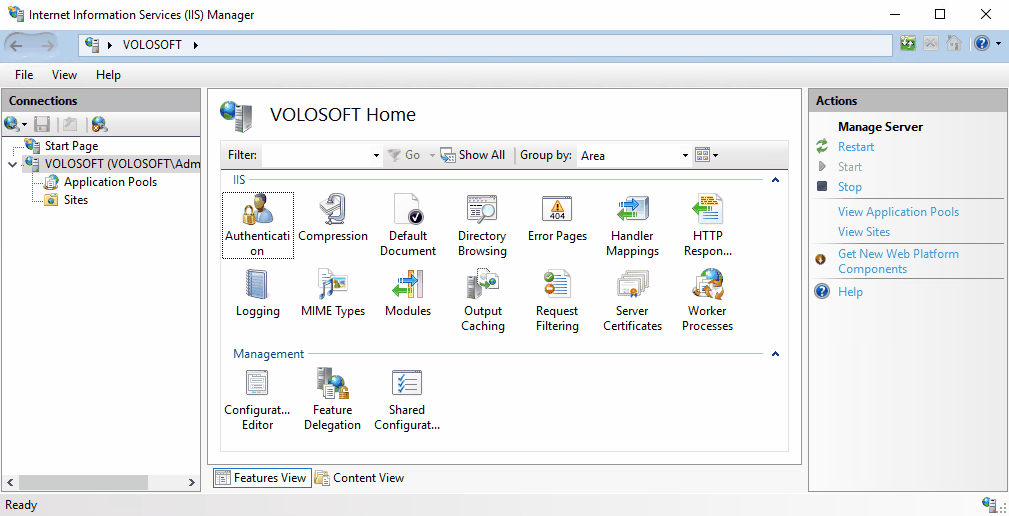
Add domain names to hosts file
Add domain names to hosts file(in Windows: C:\Windows\System32\drivers\etc\hosts, in Linux and macOS: /etc/hosts).
For example, in a tiered MVC project.
127.0.0.1 auth.sample
127.0.0.1 api.sample
127.0.0.1 web.sample
Publish the Application(s) On IIS
Update the appsettings
Update the appsettings according to your project type and domain names.
For example, in a tiered MVC project.
//AuthServer
{
"App": {
"SelfUrl": "https://auth.sample",
"CorsOrigins": "https://api.sample,https://web.sample",
"RedirectAllowedUrls": "https://api.sample,https://web.sample",
"DisablePII": "false"
},
"ConnectionStrings": {
"Default": "Server=volo.sample;Database=Sample;User Id=sa;Password=1q2w3E**;TrustServerCertificate=true"
},
"AuthServer": {
"Authority": "https://auth.sample",
"RequireHttpsMetadata": "true"
},
"StringEncryption": {
"DefaultPassPhrase": "f9uRkTLdtAZLmlh3"
},
"Redis": {
"Configuration": "volo.sample"
}
}
//HttpApi.Host
{
"App": {
"SelfUrl": "https://api.sample",
"CorsOrigins": "https://web.sample",
"DisablePII": "false",
"HealthCheckUrl": "/health-status"
},
"ConnectionStrings": {
"Default": "Server=volo.sample;Database=Sample;User Id=sa;Password=1q2w3E**;TrustServerCertificate=true"
},
"Redis": {
"Configuration": "volo.sample"
},
"AuthServer": {
"Authority": "https://auth.sample",
"RequireHttpsMetadata": "true",
"SwaggerClientId": "Sample_Swagger"
},
"StringEncryption": {
"DefaultPassPhrase": "f9uRkTLdtAZLmlh3"
}
}
//Web
{
"App": {
"SelfUrl": "https://web.sample",
"DisablePII": "false"
},
"RemoteServices": {
"Default": {
"BaseUrl": "https://api.sample/"
},
"AbpAccountPublic": {
"BaseUrl": "https://auth.sample/"
}
},
"Redis": {
"Configuration": "volo.sample"
},
"AuthServer": {
"Authority": "https://auth.sample",
"RequireHttpsMetadata": "true",
"ClientId": "Sample_Web",
"ClientSecret": "1q2w3e*"
},
"StringEncryption": {
"DefaultPassPhrase": "f9uRkTLdtAZLmlh3"
}
}
Copy the .pfx file
You need to copy pfx file from ./src/Blazor to ./publish/blazor folder.
Publish the Applications(s)
You can add as website from IIS.
For blazor we need to enable load user profile to true from application pool for created web site.
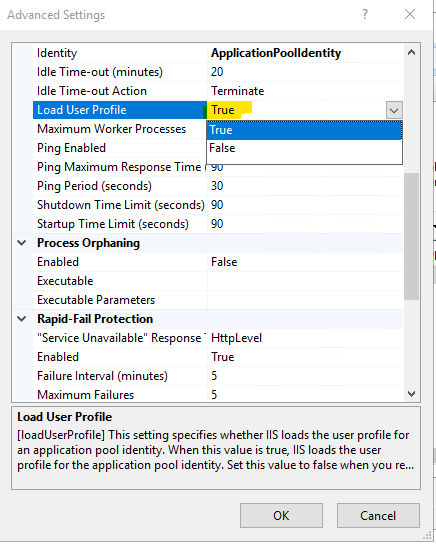
For local deployment select the SSL certificate when you add the web site.
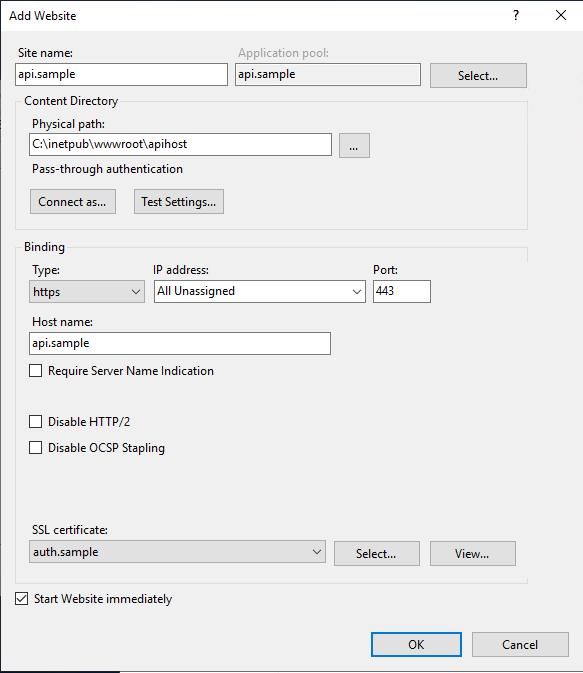
The final result should look like this (depending on your project type).
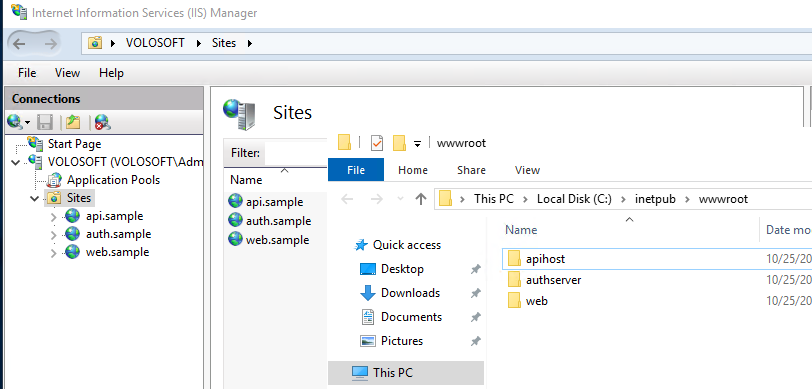
We can visit the websites from a browser.
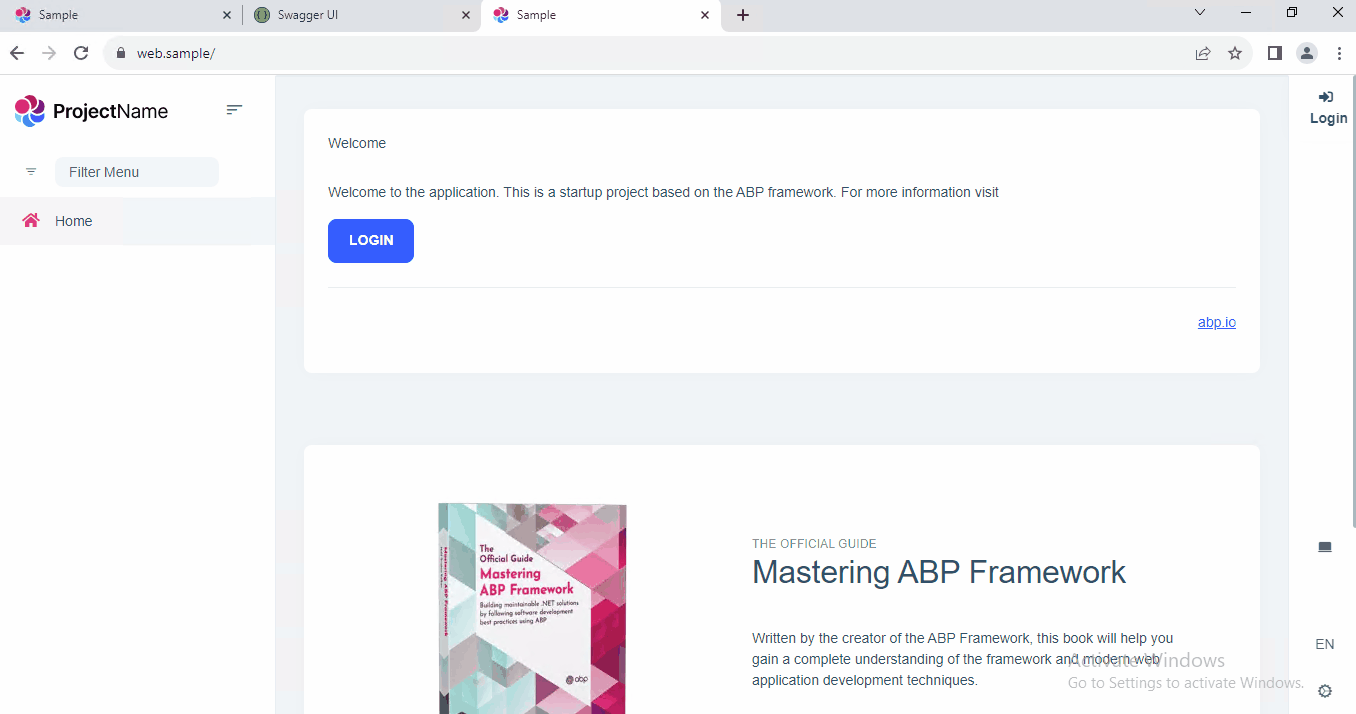
Fix 405 Method Not Allowed Error
Remove WebDAV modules and handlers from the Web.config file.
<?xml version="1.0" encoding="UTF-8"?>
<configuration>
<system.webServer>
<modules>
<remove name="WebDAVModule" />
</modules>
<handlers>
<remove name="WebDAV" />
</handlers>
</system.webServer>
</configuration>
Also remove the WebDAV Publishing feature from your computer if it's not being used. To do so, follow these steps:
- Select Start, type Turn Windows features on or off in the Start Search box, and then select Turn Windows features on or off.
- In the Windows Features window, expand Internet Information Services -> World Wide Web Services -> Common HTTP Features.
- Uncheck the WebDAV Publishing feature.
See:
- https://learn.microsoft.com/en-us/aspnet/web-api/overview/testing-and-debugging/troubleshooting-http-405-errors-after-publishing-web-api-applications#resolve-http-405-errors
- https://learn.microsoft.com/en-us/troubleshoot/developer/webapps/iis/site-behavior-performance/http-error-405-website#resolution-for-cause-3
Publish the Application(s) as IIS sub-application
If your MVC application is a sub-application, you need to set the BaseUrl property of AbpThemingOptions to the sub-application’s path. The BaseUrl is used to configure the base element in the head section of the layout page.
public void ConfigureServices(IServiceCollection services)
{
Configure<AbpThemingOptions>(options =>
{
options.BaseUrl = "/myapp/";
});
}
<html>
<head>
<base href="/myapp/" />
...
</head>
<body>
...
</body>
</html>
For Blazor applications, you can to set the base tag in the App.razor file instead of configure AbpThemingOptions.
How to get stdout-log
If your application is running on IIS and getting errors like 502.5, 500.3x, you can enable stdout logs to see the error details.
To enable and view stdout logs:
- Navigate to the site's deployment folder on the hosting system.
- If the logs folder isn't present, create the folder. For instructions on how to enable MSBuild to create the logs folder in the deployment automatically, see the Directory structure topic.
- Edit the
web.configfile. SetstdoutLogEnabledtotrueand change thestdoutLogFilepath to point to the logs folder (for example,.\logs\stdout). stdout in the path is the log file name prefix. A timestamp, process id, and file extension are added automatically when the log is created. Using stdout as the file name prefix, a typical log file is namedstdout_20180205184032_5412.log. - Ensure your application pool's identity has write permissions to the logs folder.
- Save the updated
web.configfile. - Make a request to the app.
- Navigate to the logs folder. Find and open the most recent stdout log.
The following sample aspNetCore element configures stdout logging at the relative path
.\log\.Confirm that the AppPool user identity has permission to write to the path provided.
<aspNetCore processPath="dotnet"
arguments=".\MyAbpApp.dll"
stdoutLogEnabled="true"
stdoutLogFile=".\logs\stdout"
hostingModel="inprocess">
</aspNetCore>
Reference:
IIS log creation and redirection
Troubleshoot ASP.NET Core on Azure App Service and IIS


























































